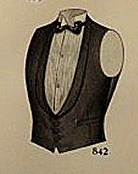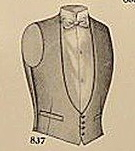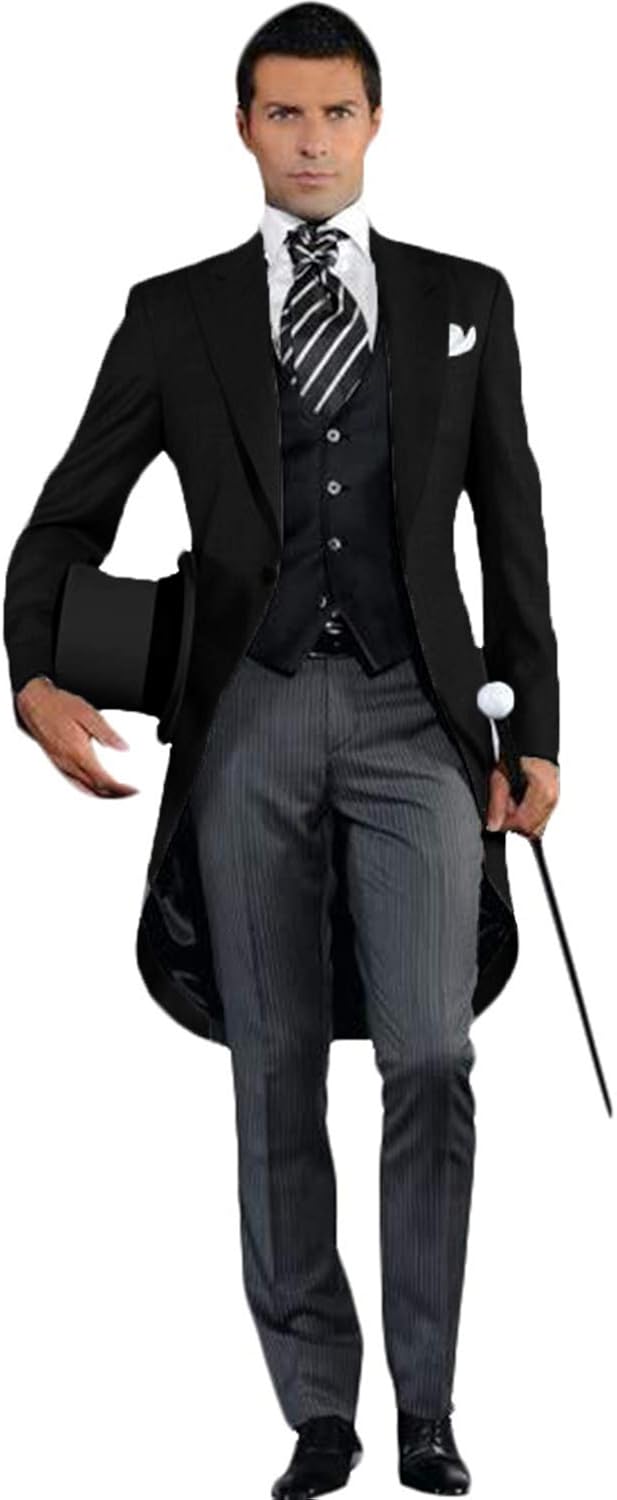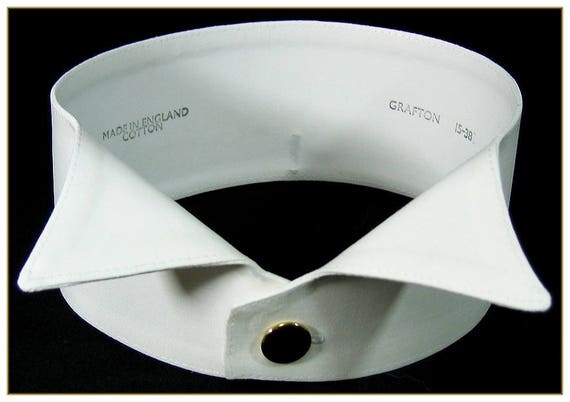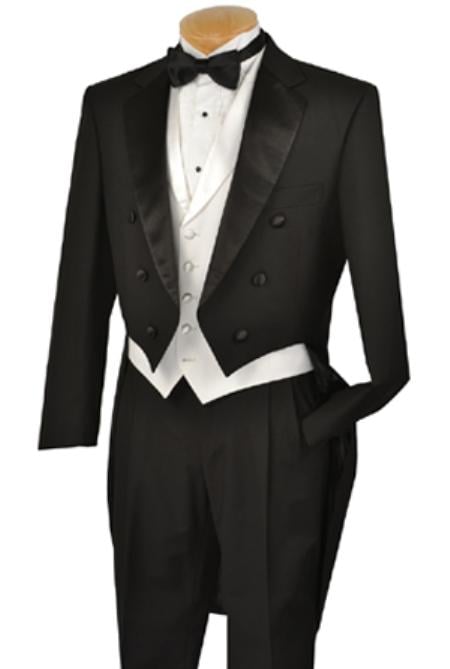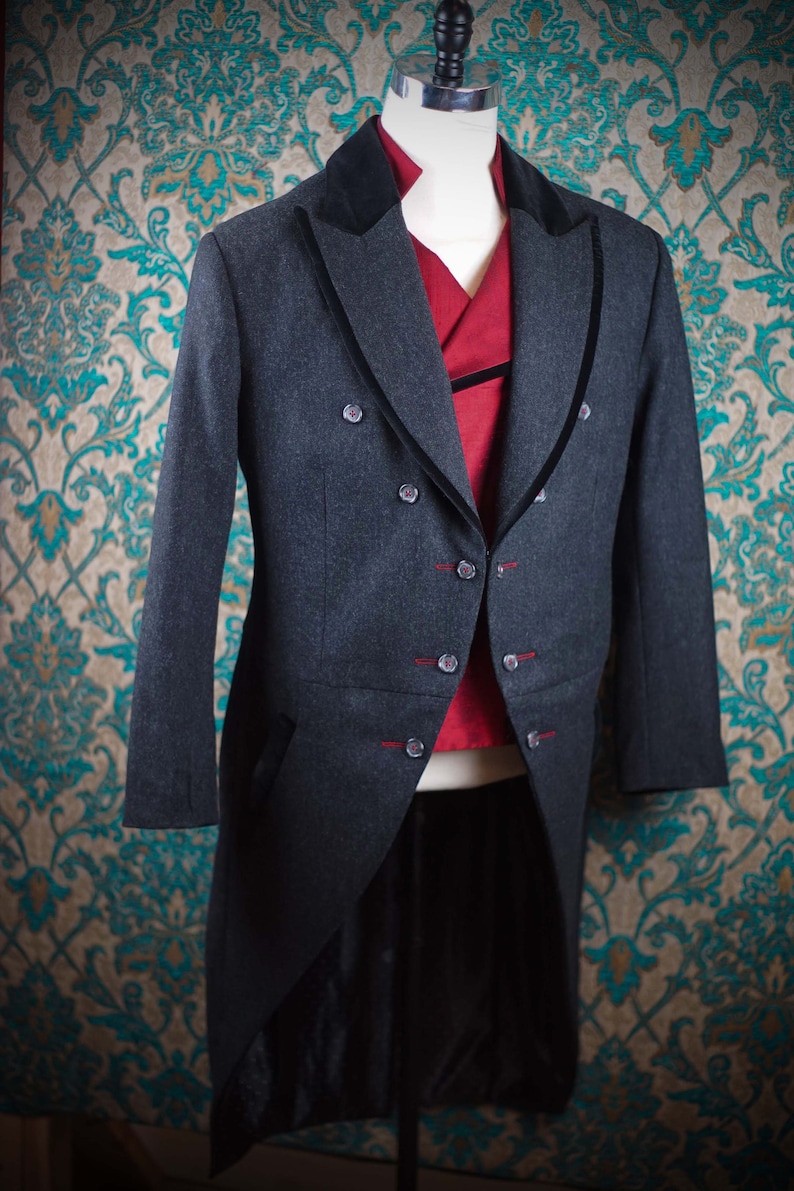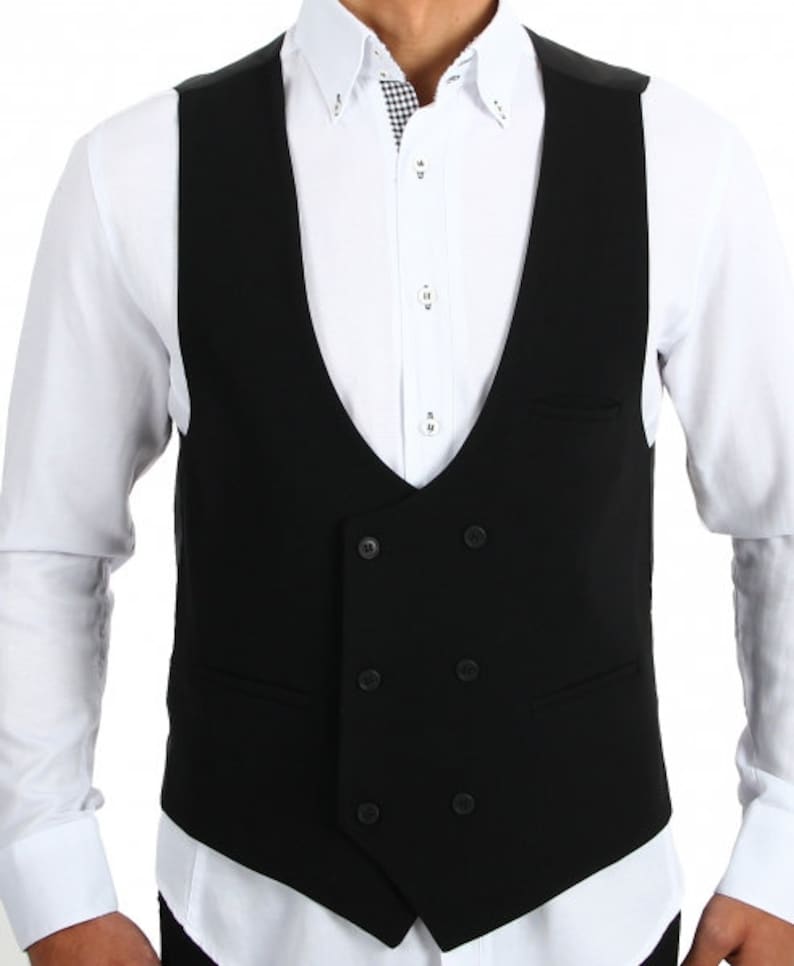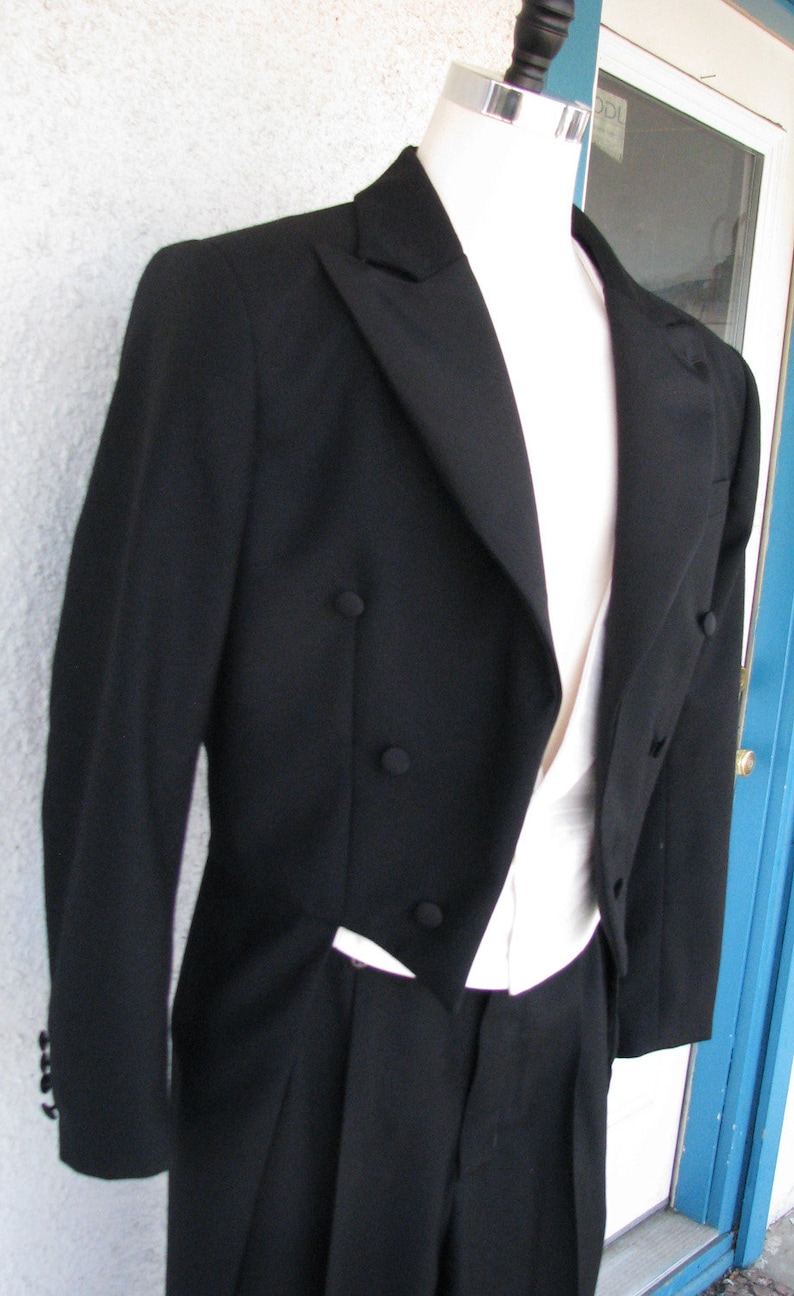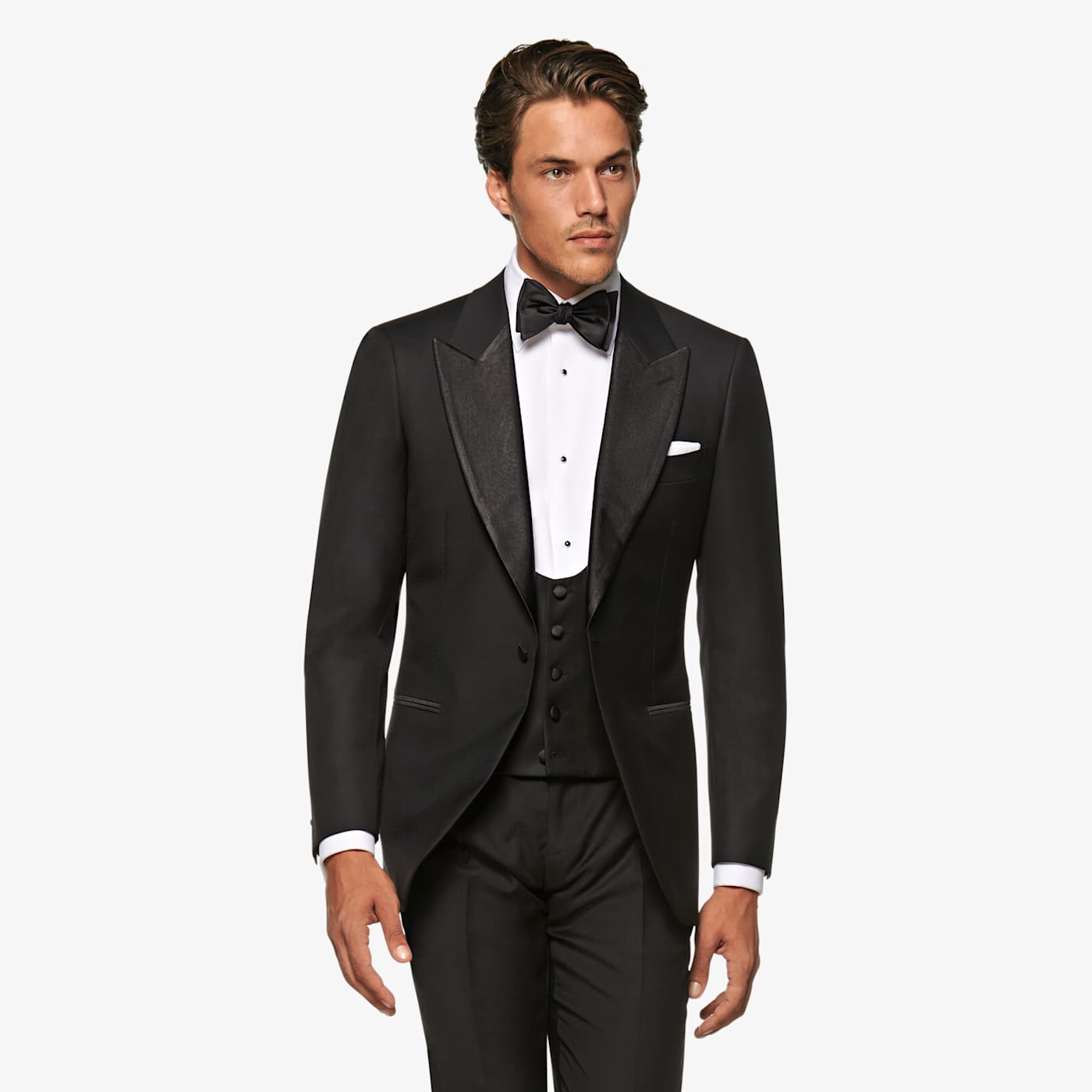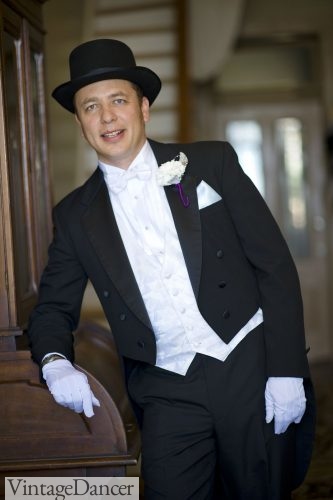
How are Victorian men’s formal wear different than today’s tuxedo? This is a topic I had to research for my husband’s Victorian wedding suit (above). Protocol in formalwear changed over the seven Victorian era decades, but the general look and feel is similar throughout and not entirely far off from today’s white-tie evening wear. The following guide will explain some of the history of men’s white and black tie full dress as well as some tips on purchase clothes for your formal Victorian event.
The Victorian era is roughly 1940 to 1900. Read this guide for post-1900 formalwear.
Victorian Men’s Tuxedo: The Tailcoat
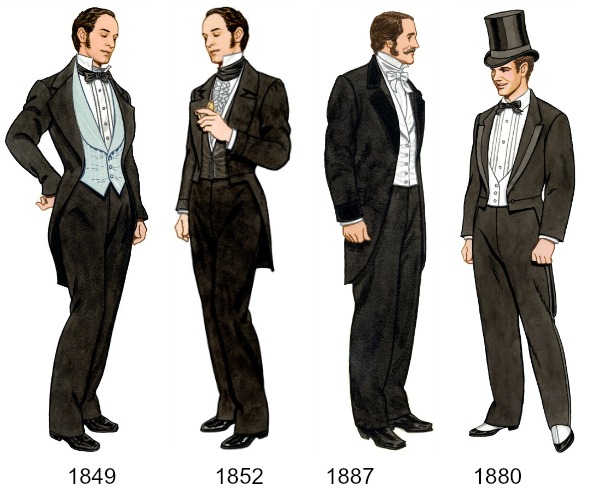
Victorian Men’s Eveningwear
The tailcoat was the correct style for evening events taking place after 6pm. It had a high straight edge around the waist and longer tails behind that hanged to mid-thigh in the early years and down to the knee by 1900. Black was the best choice for evening wear because it had a slimming effect. In the pre-1870s and briefly after 1890, men’s blue dress coats with gold gilt buttons and a blue or buff vest were popular among the fashion-forward dandies. It was a cheerful color, but too trendy for most men who replaced their evening coats every 10 years.
Besides color, evening coats were left open, to expose a nice white vest and shirt underneath. The appearance of single but usually double-breasted buttons on either side of the jacket was purely ornamental. The length and cut of tailcoats changed from season to season. In general, the front facings were cut square and lined up with the vest’s bottom edge, just below the upper waistline.
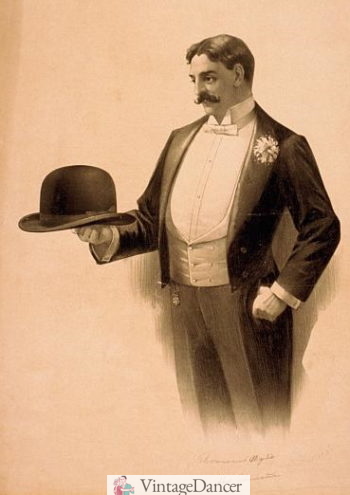
1896 tailcoat, white shawl vest, and white chrysanthemum boutonnière. Holding a derby hat.
Depending on the year and how up to fashion the man was, his tailcoat could have had peaked, notched or shawl lapels in various widths. Lapel facings were made of silk, satin or velvet and sometimes outlined with an inch of cording or fabric that matched the coat. Tailcoat lapels were notched in the V and M shapes for most of the Victorian era. The 1860s introduced the shawl collar, which remained fashionable for only a decade.
The fabric was made of a fine diagonal wool twill or corkscrew weave until the 1890s, when smooth vicuna was preferred. The fabric was quite thick and heavy. Some older men could wear suits made out of heavy broadcloth which was a bit more flexible.
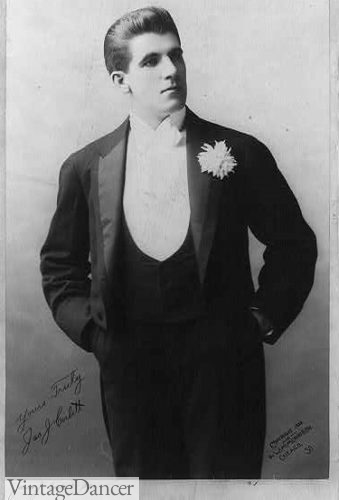
1893 James John Corbett wears a tailcoat, black vest, boutonnière, and white bow tie
The main difference between Victorian and modern tailcoats is the fit. Today’s “one size fits all” fitting leaves tailcoats hanging loosely and boxy on the body. Victorian tailcoats were fit snugly on the body using the most advanced tailoring techniques (a lost art today). Modern tailcoats also hang lower on the waist to accommodate a short pant rise. Vests, too, are longer.
For authenticity, you will have to have one made for you. But for a “looks close enough” type suit- nearly any modern tailcoat will do. Stick to black for evening wear with notch collar and decorative buttons.
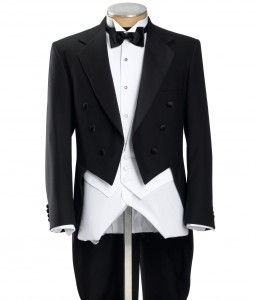
Modern tailcoat
Dinner Jackets
In the 1880s the sack-like dinner jacket was introduced as an alternative to the tailcoat. Initially, it was worn in semi-formal settings such as on cruise ships and hotel dining rooms. It transitioned into private parties, theater, and summer resorts, but steered clear of ballrooms and very ceremonial events. In France, the dinner jacket was called a smocking and in America, the tuxedo (named after the N.Y. Tuxedo Park Club, where it was first seen).
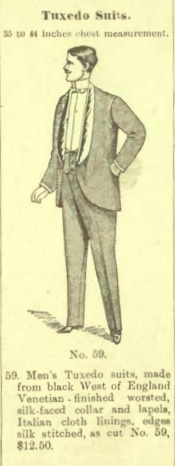
1900 dinner jacket with a black vest and bow tie
The Tuxedo jacket was cut like a short sack coat with a single-breasted closure. It hung straight from the shoulders to the hip. The front edge could be square or rounded. Most styles were black with silk lapel facings. A white version was seen occasionally at summer resorts by 1900.
Both single and double-breasted vests in black, white or grey were worn with the tuxedo coat. A black bow tie was worn with a dark vest and white bowtie was worn with a white vest. There was some argument that white ties should only be worn with tailcoats, a rule that was to become more popular in the next century.
In the summer, a derby/bowler felt hat or straw boater hat was accepted instead of the silk top hat.
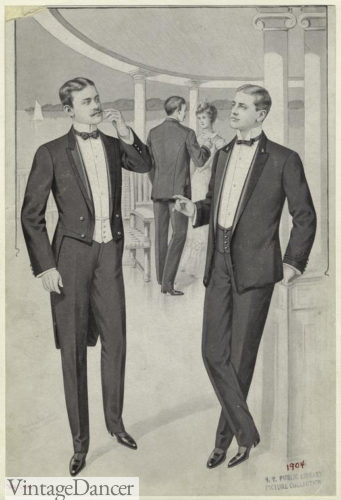
1904 tailcoat and dinner jacket side by side
Formal Waistcoat
- Black waistcoat with shawl lapel
- Grey or white waistcoat, no lapel
Elaborately embroidered waistcoats in fine silk, satin, and velvet were the eye candy of men’s Victorian formal suits. However, by the 1860s simple pique cloth or silk vests were the standard options. Black was worn for dinner and white or ivory for the ballroom. Vests were cut straight across the bottom and featured low V or U shaped necks to match that of coats. Vests were either double-breasted with 4-6 buttons or single-breasted with 3-4 cloth-covered or jeweled buttons.
Unfortunately, finding formal U shaped white vests, especially with a shawl collar, is next to impossible. Most men settle for a more modern white formal vests with a deep V cut and square lapels. Or, they opt for a full white or ivory vest that covers the shirt. Black vests will be a bit easier to find with a U or V neckline. Shop men’s vests/waistcoats.
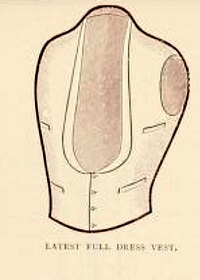
1894 white U collar formal waistcoat
Formal Victorian Men’s Pants
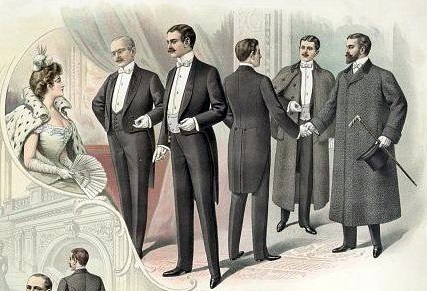
1899 men’s formalwear suits and coats
Men’s formal dress trousers (pants) haven’t changed too much in the last 100 years. The main difference is the height. Men’s Victorian pants went up and down from the belly button to rib rage depending on the fashion of the year. Legs were fitted narrowly and tapered to the ankle in the early years and widened to about 19 inches at the knee and 16 inches at the ankle for most of the century. Waistlines were very high and hips full and roomy. Out-seams featured ribbon braids, inspired by military uniforms, for most of the Victorian era while a single ribbon stripe came about in the late Victorian era. Braids and stripes were optional.
To make modern pants work for the Victorian era, I buy regular flat fronted tuxedo pants with a ribbon stripe down the sides. Since they need to fit very high on the waist I will buy them one size up and hold them up with button-on suspenders. If possible, buy locally (or online with a very good return policy) and try on your pants with your vest. You should be able to move around, raise your arms, and not have a gap showing between your vest and pants. I have been happy with Jos A Bank’s flat front tuxedo pants which have a good, classic rise. Modern tuxedo pants in skinny fit will be too short in the waist and too narrow in the leg for the correct fit.
Victorian Men’s Formal Shirts
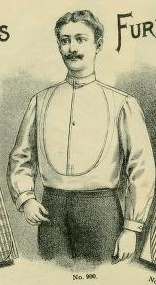
1898 bib front dress shirt
The bib front shirt was the best option for U or deep V waistcoats since the starched fronts kept the shirt flat. Some earlier fancier formal shirts had lace frills along with the front buttons but these styles are much harder to find today. Mother of pearl shirt links and cufflinks secured the shirt together instead of buttons. Pleated shirts started to appear in the mid 1890s but were slow to catch on.
The most important element of formal Victorian shirts is the collar. Stiffened upright collars appeared in the 1860s and began to display wingtips in the following decade. Turndown collars were occasionally seen in the 1860s and early ’70s.
Plain front, button-down white dress shirts will work well enough for your Victorian suit. A modern wingtip tuxedo shirt (no pleats) will also work quite well and is probably the simplest option, although harder to find without pleats.
Formal Men’s Accessories
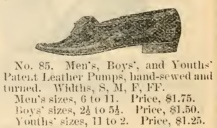
1895 evening pumps
Shoes – Traditional men’s formalwear shoes were called “pumps.” They look a bit like ladies’ low heel slippers with a bow on the toe box. Made of patent leather with a satin bow, they are not too far often from men’s traditional formal shoes today. As an alternative, you could also wear black patent leather lace-up shoes, lace-up boots, or ballroom dancing shoes. Find Victorian style men’s boots and shoes online here.
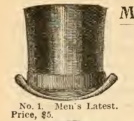
1897 tall top hat made of silk
Hats – A tall black top hat made of beaver felt or silk was what every gentleman wore to formal events and parties. Most modern top hats are made of wool or synthetic felt. These will still work OK for formal events. Just remember to take your hat off indoors to be a true Victorian gentleman. Shop for hats here.
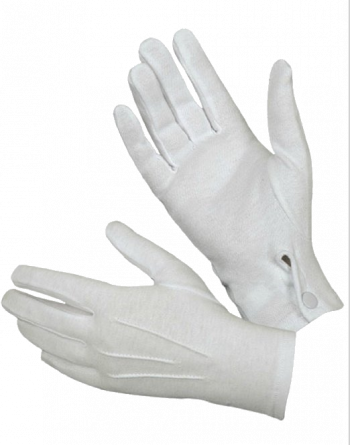
Formal white gloves with a snap at the wrist
Gloves– A pair of white or ivory kid leather gloves will formalize your outfit. Cloth will be easier to find, preferably with a button cuff, not a snap. Leave your gloves on at all times except while eating, smoking or using the restroom.
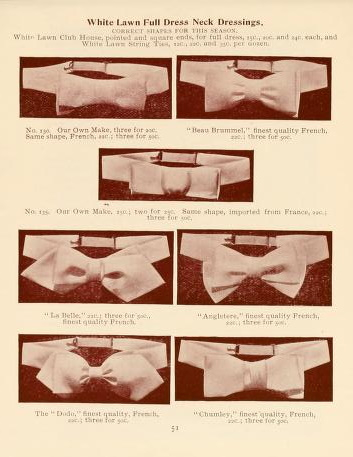
1884 men’s white tie bow tie options
Bow tie – A white silk or satin bow tie for formal and black bow tie for semi-formal evenings were the only necktie options. Shop ties.
Pocket Square – A white silk pocket square is optional. Since most tailcoats did not have a pocket, there was no place for them. However, if your new tailcoat or dinner jacket has a pocket, you may add a silk white pocket square. You could also add a white flower as a boutonnière.
Shop men’s formal clothing
To rent a tuxedo or morning suit visit The Men’s Warehouse online.
Scroll down for more history and etiquette of Victorian formal wear:
Men’s Formal Etiquette
The Gentlemen’s Guide to Etiquette, 1986
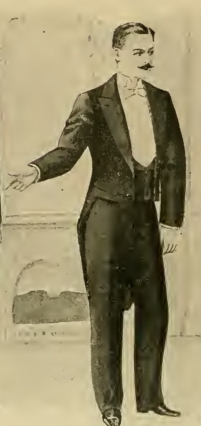
1896 black tie evening attire
On Eveningwear Fashion
“For all evening wear—black cloth trousers.
“But the tortures of evening dress do not end with our lower limbs. Of all the iniquities perpetrated under the Reign of Terror, none has lasted so long as that of the strait-jacket, which was palmed off on the people as a ‘habit de compagnie.’ If it were necessary to sing a hymn of praise to Robespierre, Marat, and Co., I would rather take the guillotine as my subject to extol than the swallow tail. And yet we endure the stiffness, unsightliness, uncomfortableness, and want of grace of the latter, with more resignation than that with which Charlotte Corday put her beautiful neck into the ‘trou d’enfer’ of the former.
Fortunately, modern republicanism has triumphed over ancient etiquette, and the tail-coat of to-day is looser and more easy than it was twenty years ago. I can only say, let us never strive to make it bearable, till we have abolished it. Let us abjure such vulgarities as silk collars, white silk linings, and so forth, which attempt to beautify this monstrosity, as a hangman might wreathe his gallows with roses. The plainer the manner in which you wear your misery, the better.
“Then, again, the black waistcoat, stiff, tight, and comfortless. Fancy Falstaff in a ball-dress such as we now wear. No amount of embroidery, gold-trimmings, or jewel-buttons will render such an infliction grateful to the mass. The best plan is to wear thorough mourning for your wretchedness. In France and America, the cooler white waistcoat is admitted. However, as we have it, let us make the best of it, and not parade our misery by hideous ornamentation. The only evening waistcoat for all purposes for a man of taste is one of simple black, with the simplest possible buttons.
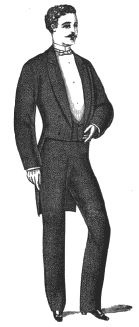
1880 men’s full dress evening attire
“These three items never vary for dinner-party, muffin-worry, or ball. The only distinction allowed is in the neck-tie. For dinner, the opera, and balls, this must be white, and the smaller the better. It should be too, of a washable texture, not silk, nor netted, nor hanging down, nor of any foppish production, but a simple, white tie, without embroidery. The black tie is admitted for evening parties, and should be equally simple. The shirt-front, which figures under the tie should be plain, with unpretending small plaits.
The glove must be white, not yellow. Recently, indeed, a fashion has sprung up of wearing lavender gloves in the evening. They are economical, and as all economy is an abomination, must be avoided. Gloves should always be worn at a ball. At a dinner-party in town they should be worn on entering the room, and drawn off for dinner.
While, on the one hand, we must avoid the awkwardness of a gallant sea-captain who, wearing no gloves at a dance, excused himself to his partner by saying, ‘Never mind, miss, I can wash my hands when I’ve done dancing,’ we have no need, in the present day, to copy the Roman gentleman mentioned by Athenæus, who wore gloves at dinner that he might pick his meat from the hot dishes more rapidly than the bare-handed guests.
As to gloves at tea-parties and so forth, we are generally safer with than without them. If it is quite a small party, we may leave them in our pocket, and in the country they are scarcely expected to be worn; but ‘touch not a cat but with a glove;’ you are always safer with them.”
On Etiquette for balls to parties
If you are to act as escort to a lady, you must call at the hour she chooses to name, and the most elegant way is to take a carriage for her. If you wish to present a bouquet, you may do so with perfect propriety, even if you have but a slight acquaintance with her.
When you reach the house of your hostess for the evening, escort your companion to the dressing-room, and leave her at the door. After you have deposited your own hat and great-coat in the gentlemen’s dressing-room, return to the ladies’ door and wait for your companion. Offer her your right arm, and lead her to the drawing-room, and, at once, to the hostess, then take her to a seat, and remain with her until she has other companions before you seek any of your own friends in the room.
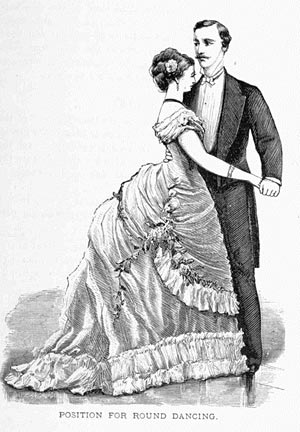
1870s at a ball
There is much more real enjoyment and sociability in a well-arranged party, than in a ball, though many of the points of etiquette to be observed in the latter are equally applicable to the former. There is more time allowed for conversation, and, as there are not so many people collected, there is also more opportunity for forming acquaintances.
At a soirée, par excellence, music, dancing, and conversation are all admissible, and if the hostess has tact and discretion this variety is very pleasing. As there are many times when there is no pianist or music engaged for dancing, you will do well, if you are a performer on the piano-forte, to learn some quadrilles, and round dances, that you may volunteer your services as orchestra. Do not, in this case, wait to be solicited to play, but offer your services to the hostess, or, if there is a lady at the piano, ask permission to relieve her. To turn the leaves for another, and sometimes call figures, are also good natured and well-bred actions.
There is one piece of rudeness very common at parties, against which I would caution you. Young people very often form a group, and indulge in the most boisterous merriment and loud laughter, for jests known only to themselves. Do not join such a group. A well-bred man, while he is cheerful and gay, will avoid any appearance of romping in society.
If dancing is to be the amusement for the evening, your first dance should be with the lady whom you accompanied, then, invite your hostess, and, if there are several ladies in the family you must invite each of them once, in the course of the evening. If you go alone, invite the ladies of the house before dancing with any of your other lady friends.
Never attempt any dance with which you are not perfectly familiar. Nothing is more awkward and annoying than to have one dancer, by his ignorance of the figures, confuse all the others in the set, and certainly no man wants to show off his ignorance of the steps of a round dance before a room full of company.
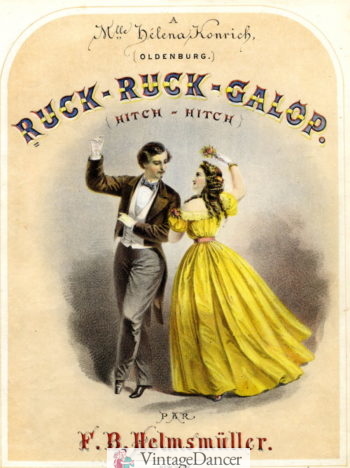
Dancing at a ball (1850s)
- Do not devote yourself too much to one lady. A party is meant to promote sociability, and a man who persists in a tête-à-tête for the evening, destroys this intention. Besides you prevent others from enjoying the pleasure of intercourse with the lady you thus monopolize.
- Avoid any affectation of great intimacy with any lady present; and even if you really enjoy such intimacy, or she is a relative, do not appear to have confidential conversation, or, in any other way, affect airs of secrecy or great familiarity.
- Dance easily and gracefully, keeping perfect time, but not taking too great pains with your steps. If your whole attention is given to your feet or carriage, you will probably be mistaken for a dancing master.
- When you conduct your partner to a seat after a dance, you may sit or stand beside her to converse, unless you see that another gentleman is waiting to invite her to dance.
- Do not take the vacant seat next to a lady unless you are acquainted with her.
- After dancing, do not offer your hand, but your arm, to conduct your partner to her seat.
- If music is called for and you are able to play or sing, do so when first invited, or, if you refuse then, do not afterwards comply. If you refuse, and then alter your mind you will either be considered a vain coxcomb, who likes to be urged; or some will conclude that you refused at first from mere caprice, for, if you had a good reason for declining, why change your mind?
- Never offer to turn the leaves of music for any one playing, unless you can read the notes, for you run the risk of confusing them, by turning too soon or too late.
- If you sing a good second, never sing with a lady unless she herself invites you. Her friends may wish to hear you sing together, when she herself may not wish to sing with one to whose voice and time she is unaccustomed.
- Do not start a conversation whilst any one is either playing or singing, and if another person commences one, speak in a tone that will not prevent others from listening to the music.
- If you play yourself, do not wait for silence in the room before you begin. If you play well, those really fond of music will cease to converse, and listen to you; and those who do not care for it, will not stop talking if you wait upon the piano stool until day dawn.
- Relatives should avoid each other at a party, as they can enjoy one another’s society at home, and it is the constantly changing intercourse, and complete sociability that make a party pleasant.
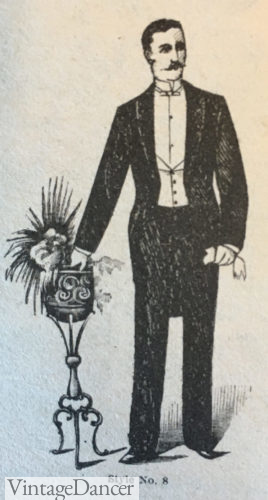
1894 full dress
Private concerts and amateur theatricals are very often the occasions for evening parties, and make a very pleasant variety on the usual dancing and small talk. An English writer, speaking of them, says:
“Private concerts and amateur theatricals ought to be very good to be successful. Professionals alone should be engaged for the former, none but real amateurs for the latter. Both ought to be, but rarely are, followed by a supper, since they are generally very fatiguing, if not positively trying. In any case, refreshments and ices should be handed between the songs and the acts. Private concerts are often given in the ‘morning,’ that is, from two to six P. M.; in the evening their hours are from eight to eleven. The rooms should be arranged in the same manner as for a reception, the guests should be seated, and as music is the avowed object, a general silence preserved while it lasts.
Between the songs, the conversation ebbs back again, and the party takes the general form of a reception. For private theatricals, however, where there is no special theatre, and where the curtain is hung, as is most common, between the folding-doors, the audience-room must be filled with chairs and benches in rows, and, if possible, the back rows raised higher than the others. These are often removed when the performance is over, and the guests then converse, or, sometimes, even dance. During the acting it is rude to talk, except in a very low tone, and, be it good or bad, you would never think of hissing.”
If you are alone, and obliged to retire early from an evening party, do not take leave of your hostess, but slip away unperceived.
If you have escorted a lady, her time must be yours, and she will tell you when she is ready to go. See whether the carriage has arrived before she goes to the dressing-room, and return to the parlor to tell her. If the weather was pleasant when you left home, and you walked, ascertain whether it is still pleasant; if not, procure a carriage for your companion. When it is at the door, join her in the drawing-room, and offer your arm to lead her to the hostess for leave-taking, making your own parting bow at the same time, then take your companion to the door of the ladies’ dressing-room, get your own hat and wait in the entry until she comes out.
When you reach your companion’s house, do not accept her invitation to enter, but ask permission to call in the morning, or the following evening, and make that call.
Debbie Sessions has been teaching fashion history and helping people dress for vintage themed events since 2009. She has turned a hobby into VintageDancer.com with hundreds of well researched articles and hand picked links to vintage inspired clothing online. She aims to make dressing accurately (or not) an affordable option for all. Oh, and she dances too.
